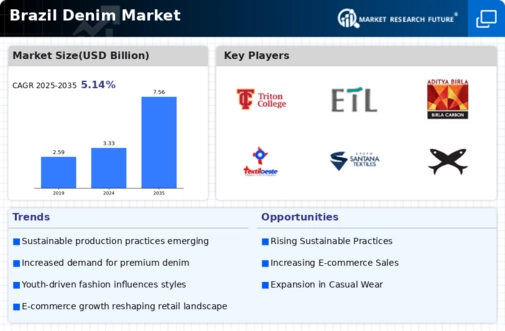Rising Disposable Income
The increasing disposable income among Brazilian consumers appears to be a pivotal driver for the denim market. As economic conditions improve, consumers are likely to allocate more funds towards fashion, including denim products. In 2025, the average disposable income in Brazil is projected to rise by approximately 5%, which could lead to a surge in demand for premium denim brands. This trend suggests that consumers may prioritize quality and brand reputation, thereby influencing purchasing decisions. The denim market in Brazil may experience a shift towards higher-priced items, as consumers seek to invest in durable and stylish denim apparel. Consequently, brands that position themselves as premium or luxury may find a growing customer base willing to pay a premium for their products.
Youth Demographic Influence
The youth demographic in Brazil, particularly those aged 15 to 30, plays a crucial role in shaping the denim market. This age group is characterized by a strong inclination towards fashion trends and brand loyalty. As of 2025, it is estimated that approximately 30% of the Brazilian population falls within this age range, indicating a substantial market segment. The preferences of this demographic often lean towards casual and trendy denim styles, which could drive innovation and variety in product offerings. Brands that effectively engage with this audience through social media and influencer marketing may see enhanced brand visibility and sales. The denim market is likely to adapt to the evolving tastes of younger consumers, emphasizing styles that resonate with their lifestyle and values.
Growing Online Retail Channels
The expansion of online retail channels is significantly impacting the denim market in Brazil. With the rise of e-commerce platforms, consumers are increasingly turning to online shopping for their denim needs. In 2025, it is estimated that online sales of denim products could account for approximately 25% of total market sales. This trend suggests that brands must enhance their online presence and optimize their digital marketing strategies to capture this growing segment. Furthermore, the convenience of online shopping may lead to increased impulse purchases, particularly among younger consumers. As a result, the denim market may witness a shift in sales strategies, with brands focusing on creating engaging online experiences to attract and retain customers.
Sustainable Production Practices
Sustainability has emerged as a critical consideration for consumers in Brazil, influencing their purchasing decisions in the denim market. As awareness of environmental issues grows, brands that adopt sustainable production practices may gain a competitive edge. In 2025, it is anticipated that around 40% of consumers in Brazil will prioritize eco-friendly products, including denim made from organic or recycled materials. This shift suggests that companies focusing on sustainable practices could attract a loyal customer base. Furthermore, the denim market may witness an increase in certifications and transparency regarding sourcing and manufacturing processes. Brands that communicate their commitment to sustainability effectively may enhance their reputation and appeal to environmentally conscious consumers.
Technological Advancements in Manufacturing
Technological advancements in manufacturing processes are likely to reshape the denim market in Brazil. Innovations such as automated production lines and advanced fabric technologies can enhance efficiency and reduce costs. In 2025, it is projected that the adoption of such technologies could lead to a 15% increase in production capacity for denim manufacturers. This improvement may enable brands to respond more swiftly to changing consumer demands and trends. Additionally, the integration of digital tools for design and marketing could streamline operations and enhance customer engagement. As a result, the denim market may experience a transformation in how products are developed and marketed, potentially leading to increased competitiveness among local brands.


















Leave a Comment